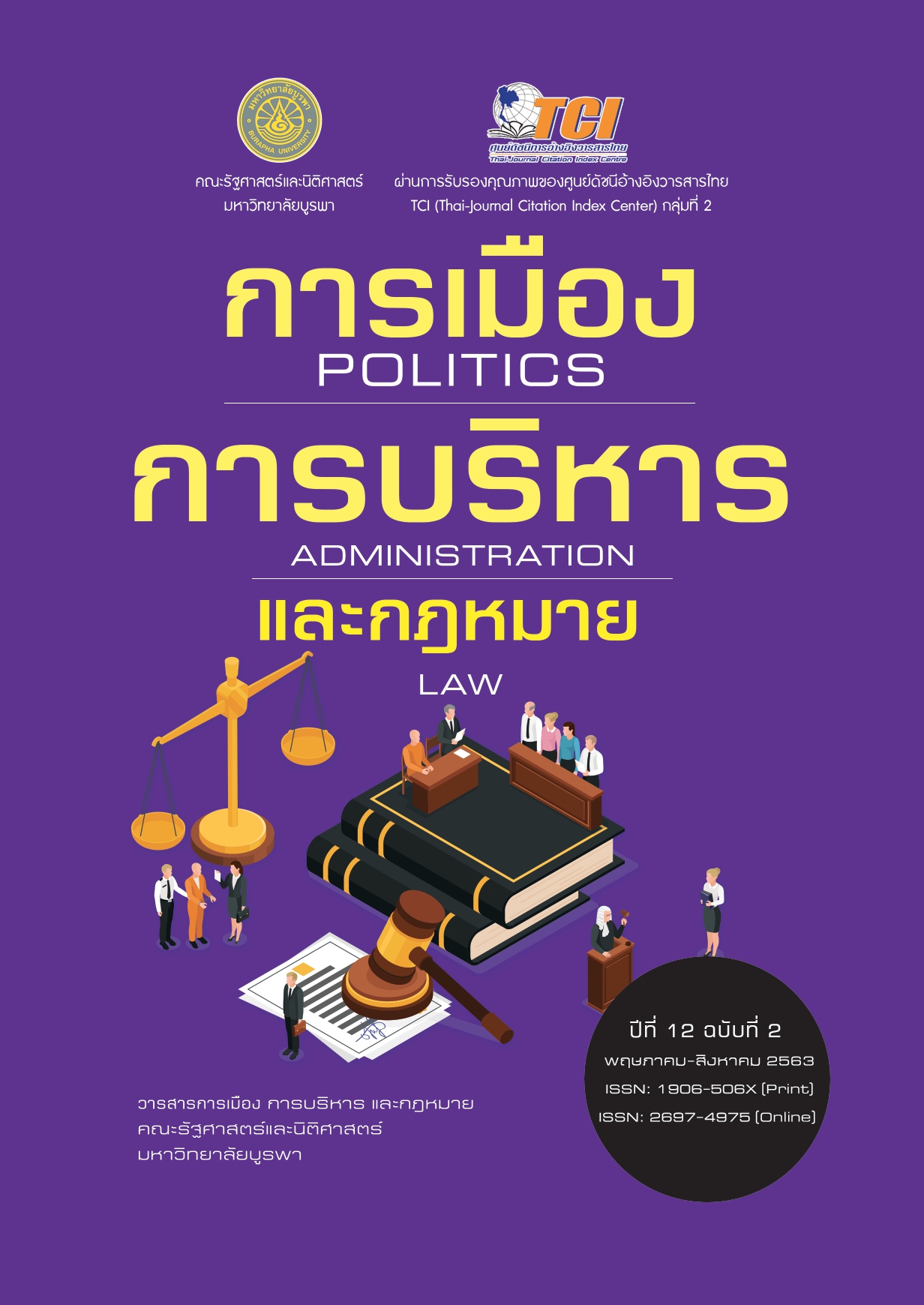รูปแบบการบริหารจัดการเชิงนโยบายเพื่อขับเคลื่อนทรัพยากรธรรมชาติและสิ่งแวดล้อมสู่ความยั่งยืน ตามแนวทาง PESTLE
คำสำคัญ:
ความยั่งยืน, นโยบาย, สิ่งแวดล้อมบทคัดย่อ
รูปแบบการบริหารจัดการเชิงนโยบายเพื่อขับเคลื่อนทรัพยากรธรรมชาติและสิ่งแวดล้อมสู่ ความยั่งยืน ตามแนวทาง PESTLE มีวัตถุประสงค์เพื่อวิเคราะห์การบริหารจัดการ ทรัพยากรธรรมชาติและสิ่งแวดล้อมตามแนวทาง PESTLE และเพื่อนำทฤษฎีอรรถประโยชน์พหุลักษณ์มาใช้ในการจัดลำดับความสำคัญของรูปแบบการบริหารจัดการเชิงนโยบายเพื่อขับเคลื่อนทรัพยากรธรรมชาติและสิ่งแวดล้อมสู่ความยั่งยืน ตามแนวทาง PESTLE ได้แบ่งการวิจัยออกเป็น 2 ส่วน ได้แก่ การสัมภาษณ์เชิงลึก และประเมินอรรถประโยชน์พหุลักษณ์ ผู้ให้ข้อมูลหลัก คือ นักวิชาการ ผู้เชี่ยวชาญ และอาจารย์มหาวิทยาลัย ที่มีความรู้ความเชี่ยวชาญด้านการบริหารจัดการ ทรัพยากรธรรมชาติและสิ่งแวดล้อม จำนวน 17 คน เครื่องมือที่ใช้เป็นแบบสัมภาษณ์ และแบบประเมินอรรถประโยชน์พหุลักษณ์ สถิติที่ใช้ในการวิจัยคือ ค่าความถี่ ร้อยละ และการวิเคราะห์เนื้อหา (Content analysis) และการประยุกต์เทคนิคกระบวนการตัดสินใจแบบวิเคราะห์ลำดับชั้น (Analysis Hierarchy Process: AHP) กับผู้ให้ข้อมูลหลัก 7 คน โดยผลการวิจัยพบว่า 1) การบริหารจัดการ ทรัพยากรธรรมชาติและสิ่งแวดล้อมตามแนวทาง PESTLE ประกอบด้วย สถานการณ์ทางการเมือง เศรษฐกิจ สังคม เทคโนโลยี กฎหมาย และปัจจัยด้านสิ่งแวดล้อม 2) การนำทฤษฎีอรรถประโยชน์พหุลักษณ์มาใช้ในการจัดลำดับความสำคัญของรูปแบบการบริหารจัดการทรัพยากรธรรมชาติและสิ่งแวดล้อมสู่ความยั่งยืน ผลการวิเคราะห์ น้ำหนักความสำคัญของรูปแบบการบริหารจัดการทรัพยากรธรรมชาติและสิ่งแวดล้อมสู่ความยั่งยืน พบว่า น้ำหนักความสำคัญของรูปแบบการบริหารจัดการทรัพยากรธรรมชาติและสิ่งแวดล้อมสู่ความยั่งยืน ด้านการปรับปรุงกฎหมายที่มีความขัดแย้งและทำให้เกิดช่องว่าง หรืออุปสรรคในการดำเนินงาน มีค่ามากที่สุด รองลงมาคือ การดำเนินงานตามข้อเสนอการปฏิรูปประเทศด้านทรัพยากรธรรมชาติและสิ่งแวดล้อมและการส่งเสริมความรู้ความเข้าใจให้กับประชาชน โดยมีค่าน้ำหนักความสำคัญเท่ากับ 49.34, 27.62 และ 23.04 ตามลำดับ ผลการวิเคราะห์อัตราส่วนความสอดคล้องของทุกด้านที่ได้มีค่าเท่ากับ 0.080 – 0.096 โดยมีค่าน้อยกว่า 0.01 อยู่ในเกณฑ์ที่ยอมรับได้ สอดคล้องในทุกมิติ จึงสรุปได้ว่า ผู้เชี่ยวชาญเห็นด้วยกับรูปแบบการบริหารจัดการทรัพยากรธรรมชาติและสิ่งแวดล้อมสู่ความยั่งยืน สามารถนำรูปแบบดังกล่าวไปใช้ได้
เอกสารอ้างอิง
จันทนา อินทปัญญา. (2548). การจัดการสิ่งแวดล้อมและการพัฒนาอย่างยั่งยืน. วารสารการจัดการสิ่งแวดล้อม, 1(1), 2-3.
สุวิมล ว่องวาณิช. (2550). การวิจัยประเมินความต้องการจำเป็น. กรุงเทพฯ: สำนักพิมพ์แห่งจุฬาลงกรณ์มหาวิทยาลัย.
สุภางค์ จันทวานิช. (2552). การวิเคราะห์ข้อมูลในการวิจัยเชิงคุณภาพ (พิมพ์ครั้งที่ 9). กรุงเทพฯ: สำนักพิมพ์แห่งจุฬาลงกรณ์มหาวิทยาลัย.
สำนักงานคณะกรรมการพัฒนาการเศรษฐกิจและสังคมแห่งชาติ. (2546). การพัฒนาที่ยั่งยืน: เอกสารประกอบการประชุมประจำปี 2546. กรุงเทพฯ: สำนักงานคณะกรรมการพัฒนาการเศรษฐกิจและสังคมแห่งชาติ.
Altschuld, J. W. (2003). Delphi Techniques. lecture, Applied evaluation Design. The Ohio State University.
André Andrade Longaray et al. (2015). Assessment of a Brazilian public hospital’s performance for management purposes: A soft operations research case in action. Operations Research for Health Care, 5, 28-48.
Denzin, N. K. (1978). The research act: A theoretical introduction to sociological methods (2nded.). New York: McGraw-Hill.
Hadadian, A. R., & Rasoulian, A. (2017). Using Analytic Hierarchy Process (AHP) for Selecting the Appropriate Country for Economic Integration (Case of Iran’s Foreign Trade with OIC Countries). International Research Journal of Finance and Economics, 162(July).
Intapanya, J. (2005). Environmental Management and Sustainable Development. Environmental management and sustainable development. Journal of Environmental Management, 1(1), 1-20.
Kraft, M. E. (2003). Environmental Policy and Politics (3rd ed.). Harrisonburg: Pearson Education.
Kunmin, Z. Zongguo, W. Liying, P. (2007). Environmental Policies in China: Evolvement, Features and Evaluation. China Population, Resources and Environment, 17(2), March 2007.
McMillan, T. T. (1971). The Delphi Technique. paper presented at annual meeting of California Junior. In College Association Commission on Research and Development, (3 May 1971) Monterrey California.
Photisita, C. (2011). Science and Art of Qualitative Research. 5th edition. Bangkok: Amarin Printing and Publishing.
Posavac, E., & Carey, R. (1980). Program evaluation: Methods and case studies. Englewood Cliffs, NJ: Prentice-Hall.
Chantawanitch, S. (2009). Qualitative research methods. 17th edition. Bangkok: Publisher of Chulalongkorn University
Wongwanitch, S. (2007). Needs assessment research. Bangkok: Publisher of Chulalongkorn University.






